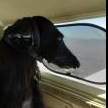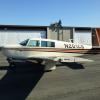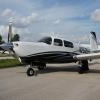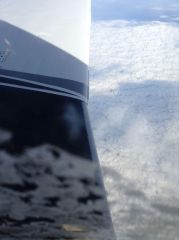Search the Community
Showing results for tags 'ice'.
-
An interesting article from Fraunhofer institute in Germany about making aircraft surfaces less sticky in ice conditions using Direct Laser Interference Patterning (DLIP). It will be very interesting if this technique could also make surfaces non-sticky in freezing rain. https://www.archiv.fraunhofer.de/Fraunhofer_magazine_1_2020/#46
-
For those not familiar with reported runway conditions for landing or departing (particularly in the winter), here is the criteria airports use to report conditions. They will be given by NOTAM or verbally by the tower during approach. There will be 3 numbers provided correlating with the 1st 1/3rd, 2nd 1/3rd and last 1/3rd of the runway (example 5/5/5). Hope this is helpful. Runway Condition.pdf If interested in the entire FAA circular, from which the chart was extracted, here is the link: https://www.faa.gov/documentLibrary/media/Advisory_Circular/AC_91-79A.pdf
-
So, the cold weather is upon us and even though you may not have TKS panels and FIKI capability, you may find frost, snow or even ice on your plane that needs to be managed prior to any flight. The days of "polishing" frost smooth prior to flight were officially deemed unacceptable by the FAA Feb 2010. I've seen guys scrape surfaces with an ice remover, credit card or just a gloved finger. If you don't have access to a heated hanger here is a cheap, quick and effective alternative. I used an empty spray bottle with 91% isopropyl alcohol and a little TKS fluid (mixed 75/25). I sprayed a portion of the wing the night prior and the frost literally just wiped off while untreated areas were rather adherent. Spraying adherent frost/ice the morning of was also painless but took a little extra time and perhaps a little more fluid. I used about 1 qt. for the entire plane. Cost was under $3.00. The best part.....essentially no elbow grease and no damage to paint.
-
So...How many sample fuel for water via the sump drain during winter with ambient temps below freezing? As for me...I don't. It may seem elementary but early in my flying career in Minot, ND with temps of below -20℉ I checked the fuel via the sump only to have a small piece of ice keep the sump open draining fuel onto the ground. It was difficult to get it to stop.
-
Just curious. Living in the Pacific NW, as many of you suspect, we have a few cloudy days in the winter. Trying to go east involves climbing over an MEA of 8400' or going down to the Portland area where the MEA is 7000'. Since I've been avoiding potential icing like the plague, it limits doing Angel Flights over to the Spokane area. My philosophy has been, whether moderate icing is predicted or not, if a look at the skew-t doesn't indicate that I can be above the weather by the freezing level, I don't go. I either want to be able to stay below the weather or climb through it and be on top before I get to the freezing level. Wondering what others think. Light icing? Trace icing? Time exposure during a climb/descent through the weather?
-
As a PPL student earlier this year, I spent many, many hours trolling these forums as well as other sites, trying to glean the benefits of others' experience. My goal was to acquire a plane that I could fly to/from client sites all over the east and midwest. I want to share some of my recent thoughts/decisions in case someone else comes along who is looking for similar info. I bought Parker's Encore-converted 252 in July, about the same week as I got my PPL. I thought really hard about whether I needed TKS at the time, but it was a big jump price-wise to find something already equipped. And, N252BH was such a nice plane... I went ahead and bought it and figured I'd sort through the TKS issue when I got to it. Fast forward to now, and I'm about 10 hours from getting my IFR. I've been trying to fly back and forth from my home in southern Missouri to a client site in eastern PA, every week. Let's just say that, as a VFR pilot in a non-deiced airplane, my opportunities to fly an 800 nm route to the northeast have been severely limited. I'm still flying commercially as a "fallback" 3 trips out of 4. First it was frequent IMC that kept me on the ground, and as the weather has turned colder, now it's ice. Doh! but I insist on learning the hard way, I guess. I thought really, really hard about where to go from here. Getting the IFR will help, but doesn't solve the ice problem. Short of not flying, I considered these options: a) trade up to a newer Mooney with FIKI buy a booted Baron as my winter commuter and load hauler (very appealing in some ways) c) upgrade 252BH with TKS If I were able to a find a partner, I'd love to have a B55 Baron. But I don't want to take on the financial responsibility for a twin, as a sole owner. When I see how many of those poor birds have been sitting on the market for years on end, I cringe at the thought of ever trying to sell one. And I looked at John G's transition from his Bravo to an Aerostar and, well, that's a whole 'nother league of cost. Be nice to have that 2nd engine in night-time IMC though... As for upgrading to a newer plane, it's a big jump price-wise to get to a FIKI Mooney that interests me. And, 252BH has a 1050lb useful load - it would be hard to replace that. It's got nice new paint thanks to Parker, and it's a low time airframe. The final data point came this past Monday, when I flew up to PA with an instructor. We picked up moderate rime ice on our climb to FL190, and ended up having to go to FL230 to get above the tops. At FL230, 252BH was doing this: Manifold: 28.5" RPM: 2400 or so OAT: -22C or so TAS: 207 kts, calibrated Fuel: 11.2 GPH, 25 deg LOP That was the first time I'd been above 15,500 MSL, and I was really pleased with the performance at FL230. I wouldn't want to fly that high all the time -- after 3 hours on oxygen I was feeling pretty crunchy by the time we landed. But nice to know the plane can do it, and maybe I'll adjust.... So I bit the bullet yesterday and booked an order for TKS and some new avionics. I had planned to get inadvertent TKS, but CAV and AirNet (installer) essentially refused to quote it. I was torn over the choice anyway, so with their "encouragement", FIKI it shall be. I feel good about that, although not about the cost. <cough> One other note: I decided that, while the plane was down for TKS, I'd go ahead and do some avionics and interior work. I talked to a number of shops around the country, hoping to find at least two places that could do all three tasks. Airnet Aviation at KLCK (Rickenbacker - Columbus OH) was the only shop I could find that could handle all three. I looked at breaking it up into 2 phases, but it's both cheaper and less downtime to do it this way. Here's hoping that goes well.
-
From the album: N252BH
Moderate rime ice on Dec 2 2013 at Fl190 to Fl210






